Tribological Improvement of Low-Viscosity Nanolubricants: MoO3, MoS2, WS2 and WC Nanoparticles as Additives
Abstract
:1. Introduction
2. Materials and Methods
2.1. Base Oil and Additives
2.2. Nanolubricants Formulation
2.3. Friction and Wear Analysis: Pure Sliding Conditions
2.4. Rolling–Sliding Tests: Stribeck Curves
3. Results
3.1. Pure Sliding Tests: Friction and Wear Results
3.2. Results Found in Rolling–Sliding Tests
4. Conclusions
- -
- The friction coefficients reached with all nanolubricants are minor compared to those obtained for the PAO4 oil for the tribological tests (pure sliding and rolling/sliding).
- -
- The largest friction decreases in the pure sliding tests were obtained for the MoS2 nanolubricants (0.10 wt%), with a maximum 64% friction reduction.
- -
- All the nanolubricants demonstrated an improved antiwear performance in comparison to PAO4. MoS2 nanolubricants reached the best antiwear behavior with width reductions of 62% and 58% for 0.1 wt% and 1 wt% in MoS2, respectively.
- -
- From the roughness analysis and Raman mappings of worn pins tested in pure sliding circumstances, it is suggested that the lubrication mechanism of MoS2 nanolubricants might be explained by the creation of a tribofilm and the mending effects.
- -
- Concerning the rolling/sliding tests (small slide-to-roll ratio (SRR)), the antifriction capability of MoS2 NPs is remarkable at low speeds, indicating that the use of NPs is vital in boundary lubrication.
Supplementary Materials
Author Contributions
Funding
Data Availability Statement
Acknowledgments
Conflicts of Interest
References
- Holmberg, K.; Erdemir, A. The impact of tribology on energy use and CO2 emission globally and in combustion engine and electric cars. Tribol. Int. 2019, 135, 389–396. [Google Scholar] [CrossRef]
- Gupta, A. Characterization of Engine and Transmission Lubricants for Electric, Hybrid, and Plug-In Hybrid Vehicles. Ph.D. Thesis, Ohio State University, Columbus, OH, USA, 2012. [Google Scholar]
- Aguilar-Rosas, O.A.; Alvis-Sánchez, J.A.; Tormos, B.; Marín-Santibáñez, B.M.; Pérez-González, J.; Farfan-Cabrera, L.I. Enhancement of low-viscosity synthetic oil using graphene nanoparticles as additives for enduring electrified tribological environments. Tribol. Int. 2023, 188, 108848. [Google Scholar] [CrossRef]
- Mariño, F.; Liñeira del Río, J.M.; López, E.R.; Fernández, J. Chemically modified nanomaterials as lubricant additive: Time stability, friction, and wear. J. Mol. Liq. 2023, 382, 121913. [Google Scholar] [CrossRef]
- Ahmed Abdalglil Mustafa, W.; Dassenoy, F.; Sarno, M.; Senatore, A. A review on potentials and challenges of nanolubricants as promising lubricants for electric vehicles. Lubr. Sci. 2022, 34, 1–29. [Google Scholar] [CrossRef]
- Gulzar, M.; Masjuki, H.H.; Kalam, M.A.; Varman, M.; Zulkifli, N.W.M.; Mufti, R.A.; Zahid, R. Tribological performance of nanoparticles as lubricating oil additives. J. Nanopart. Res. 2016, 18, 223. [Google Scholar] [CrossRef]
- Liñeira del Río, J.M.; Mariño, F.; López, E.R.; Gonçalves, D.E.P.; Seabra, J.H.O.; Fernández, J. Tribological enhancement of potential electric vehicle lubricants using coated TiO2 nanoparticles as additives. J. Mol. Liq. 2023, 371, 121097. [Google Scholar] [CrossRef]
- Demas, N.; Timofeeva, E.; Routbort, J.; Fenske, G. Tribological Effects of BN and MoS2 Nanoparticles Added to Polyalphaolefin Oil in Piston Skirt/Cylinder Liner Tests. Tribol. Lett. 2012, 47, 91–102. [Google Scholar] [CrossRef]
- Kalin, M.; Kogovšek, J.; Remškar, M. Mechanisms and improvements in the friction and wear behavior using MoS2 nanotubes as potential oil additives. Wear 2012, 280–281, 36–45. [Google Scholar] [CrossRef]
- Lee, E.L.; Wachs, I.E. In Situ Spectroscopic Investigation of the Molecular and Electronic Structures of SiO2 Supported Surface Metal Oxides. J. Phys. Chem. C 2007, 111, 14410–14425. [Google Scholar] [CrossRef]
- Nagarajan, T.; Khalid, M.; Sridewi, N.; Jagadish, P.; Shahabuddin, S.; Muthoosamy, K.; Walvekar, R. Tribological, oxidation and thermal conductivity studies of microwave synthesised molybdenum disulfide (MoS2) nanoparticles as nano-additives in diesel based engine oil. Sci. Rep. 2022, 12, 14108. [Google Scholar] [CrossRef]
- Mousavi, S.B.; Heris, S.Z.; Estellé, P. Experimental comparison between ZnO and MoS2 nanoparticles as additives on performance of diesel oil-based nano lubricant. Sci. Rep. 2020, 10, 5813. [Google Scholar] [CrossRef]
- Yi, M.; Qiu, J.; Xu, W. Tribological performance of ultrathin MoS2 nanosheets in formulated engine oil and possible friction mechanism at elevated temperatures. Tribol. Int. 2022, 167, 107426. [Google Scholar] [CrossRef]
- Yu, R.; Liu, J.; Zhou, Y. Experimental Study on Tribological Property of MoS2 Nanoparticle in Castor Oil. J. Tribol. 2019, 141, 102001. [Google Scholar] [CrossRef]
- Ouyang, T.; Lei, W.; Tang, W.; Shen, Y.; Mo, C. Experimental investigation of the effect of IF-WS2 as an additive in castor oil on tribological property. Wear 2021, 486–487, 204070. [Google Scholar] [CrossRef]
- Srinivas, V.; Thakur, R.N.; Jain, A.K.; Saratchandra Babu, M. Physicochemical properties and tribological performance of motorbike lubricant dispersed with surface-modified WS2 nanoparticles. Proc. Inst. Mech. Eng. Part J J. Eng. Tribol. 2019, 233, 1379–1388. [Google Scholar] [CrossRef]
- Guan, Z.; Zhang, P.; Florian, V.; Wu, Z.; Zeng, D.; Liu, J.; Wang, B.; Tu, X.; Li, S.; Li, W. Preparation and tribological behaviors of magnesium silicate hydroxide-MoS2 nanoparticles as lubricant additive. Wear 2022, 492–493, 204237. [Google Scholar] [CrossRef]
- Srivastava, J.; Nandi, T.; Trivedi, R.K. Experimental Investigations on Thermophysical, Tribological and Rheological Properties of MoS2 and WS2 Based Nanolubricants with Castor Oil as Base Lubricant. Tribol. Ind. 2023, 45, 591–603. [Google Scholar] [CrossRef]
- Sepehrnia, M.; Maleki, H.; Forouzandeh Behbahani, M. Tribological and rheological properties of novel MoO3-GO-MWCNTs/5W30 ternary hybrid nanolubricant: Experimental measurement, development of practical correlation, and artificial intelligence modeling. Powder Technol. 2023, 421, 118389. [Google Scholar] [CrossRef]
- Zhang, X.; Wan, S.; Pu, J.; Wang, L.; Liu, X. Highly hydrophobic and adhesive performance of graphene films. J. Mater. Chem. 2011, 21, 12251–12258. [Google Scholar] [CrossRef]
- Nyamekye, C.K.A.; Bobbitt, J.M.; Zhu, Q.; Smith, E.A. The evolution of total internal reflection Raman spectroscopy for the chemical characterization of thin films and interfaces. Anal. Bioanal. Chem. 2020, 412, 6009–6022. [Google Scholar] [CrossRef] [PubMed]
- Okubo, H.; Tadokoro, C.; Hirata, Y.; Sasaki, S. In Situ Raman Observation of the Graphitization Process of Tetrahedral Amorphous Carbon Diamond-Like Carbon under Boundary Lubrication in Poly-Alpha-Olefin with an Organic Friction Modifier. Tribol. Online 2017, 12, 229–237. [Google Scholar] [CrossRef]
- Klinbumrung, A.; Thongtem, T.; Thongtem, S. Characterization of Orthorhombic Characterization of Orthorhombic α-MoO3 Microplates Produced by a Microwave Plasma Process. J. Nanomater. 2012, 2012, 930763. [Google Scholar] [CrossRef]
- Siciliano, T.; Tepore, A.; Filippo, E.; Micocci, G.; Tepore, M. Characteristics of molybdenum trioxide nanobelts prepared by thermal evaporation technique. Mater. Chem. Phys. 2009, 114, 687–691. [Google Scholar] [CrossRef]
- Penyediaan, Z.; Sulfida, L.; Peralihan, B.; Nano, M.; Kaedah, H.; Pua, F.L.; Chia, C.-h.; Zakaria, S.; Liew, T.-K.; Yarmo, A.; et al. Preparation of Transition Metal Sulfide Nanoparticles via Hydrothermal Route. Sains Malays. 2010, 39, 243–248. [Google Scholar]
- Philias, J.M.; Marsan, B. FTIR spectroscopic study and thermal and electrical properties of polymer electrolytes containing a cesium thiolate/disulfide redox couple. Electrochim. Acta 1999, 44, 2351–2363. [Google Scholar] [CrossRef]
- Philip, D.; Eapen, A.; Aruldhas, G. Vibrational and Surface Enhanced Raman Scattering Spectra of Sulfamic Acid. J. Solid State Chem. 1995, 116, 217–223. [Google Scholar] [CrossRef]
- Hoffmann, P.; Galindo, H.; Zambrano, G.; Rincón, C.; Prieto, P. FTIR studies of tungsten carbide in bulk material and thin film samples. Mater. Charact. 2003, 50, 255–259. [Google Scholar] [CrossRef]
- Wu, J.; Yue, G.; Xiao, Y.; Huang, M.; Lin, J.; Fan, L.; Lan, Z.; Lin, J.-Y. Glucose Aided Preparation of Tungsten Sulfide/Multi-Wall Carbon Nanotube Hybrid and Use as Counter Electrode in Dye-Sensitized Solar Cells. ACS Appl. Mater. Interfaces 2012, 4, 6530–6536. [Google Scholar] [CrossRef]
- Malyala, L.; Rani, J. WS2/Graphene Composite as Cathode for Rechargeable Aluminum-Dual Ion Battery. J. Electrochem. Soc. 2020, 167, 070501. [Google Scholar] [CrossRef]
- Handzlik, J. DFT study of molybdena–silica system—A selection of density functionals based on their performance in thermochemistry of molybdenum compounds. Chem. Phys. Lett. 2009, 469, 140–144. [Google Scholar] [CrossRef]
- Lee, C.; Yan, H.; Brus, L.E.; Heinz, T.F.; Hone, J.; Ryu, S. Anomalous Lattice Vibrations of Single- and Few-Layer MoS2. ACS Nano 2010, 4, 2695–2700. [Google Scholar] [CrossRef]
- Yan, Y.; Xia, B.; Qi, X.; Wang, H.; Xu, R.; Wang, J.-Y.; Zhang, H.; Wang, X. Nano-tungsten carbide decorated graphene as co-catalysts for enhanced hydrogen evolution on molybdenum disulfide. Chem. Commun. 2013, 49, 4884–4886. [Google Scholar] [CrossRef]
- Berkdemir, A.; Gutiérrez, H.R.; Botello-Méndez, A.R.; Perea-López, N.; Elías, A.L.; Chia, C.-I.; Wang, B.; Crespi, V.H.; López-Urías, F.; Charlier, J.-C.; et al. Identification of individual and few layers of WS2 using Raman Spectroscopy. Sci. Rep. 2013, 3, 1755. [Google Scholar] [CrossRef]
- Liñeira del Río, J.M.; López, E.R.; Fernández, J.; García, F. Tribological properties of dispersions based on reduced graphene oxide sheets and trimethylolpropane trioleate or PAO 40 oils. J. Mol. Liq. 2019, 274, 568–576. [Google Scholar] [CrossRef]
- Heyer, P.; Läuger, J. Correlation between friction and flow of lubricating greases in a new tribometer device. Lubr. Sci. 2009, 21, 253–268. [Google Scholar] [CrossRef]
- Vallejo, J.P.; Liñeira del Río, J.M.; Fernández, J.; Lugo, L. Tribological performance of silicon nitride and carbon black Ionanofluids based on 1-ethyl-3-methylimidazolium methanesulfonate. J. Mol. Liq. 2020, 319, 114335. [Google Scholar] [CrossRef]
- Läuger, J.; Pondicherry, K. New Insights into the Use of a Rotational Rheometer as Tribometer. Annu. Trans. Nord. Rheol. Soc. 2017, 25, 333–340. [Google Scholar]
- Liñeira del Río, J.M.; López, E.R.; González Gómez, M.; Yáñez Vilar, S.; Piñeiro, Y.; Rivas, J.; Gonçalves, D.E.P.; Seabra, J.H.O.; Fernández, J. Tribological Behavior of Nanolubricants Based on Coated Magnetic Nanoparticles and Trimethylolpropane Trioleate Base Oil. Nanomaterials 2020, 10, 683. [Google Scholar] [CrossRef] [PubMed]
- Sun, J.; Meng, Y.; Zhang, B. Tribological Behaviors and Lubrication Mechanism of Water-based MoO3 Nanofluid during Cold Rolling Process. J. Manuf. Process. 2021, 61, 518–526. [Google Scholar] [CrossRef]
- Lahouij, I.; Dassenoy, F.; Vacher, B.; Martin, J.-M. Real Time TEM Imaging of Compression and Shear of Single Fullerene-Like MoS2 Nanoparticle. Tribol. Lett. 2012, 45, 131–141. [Google Scholar] [CrossRef]
- Tannous, J.; Dassenoy, F.; Lahouij, I.; Le Mogne, T.; Vacher, B.; Bruhács, A.; Tremel, W. Understanding the Tribochemical Mechanisms of IF-MoS2 Nanoparticles Under Boundary Lubrication. Tribol. Lett. 2011, 41, 55–64. [Google Scholar] [CrossRef]
- Xu, Y.; Hu, E.; Hu, K.; Xu, Y.; Hu, X. Formation of an adsorption film of MoS2 nanoparticles and dioctyl sebacate on a steel surface for alleviating friction and wear. Tribol. Int. 2015, 92, 172–183. [Google Scholar] [CrossRef]
- Dai, W.; Kheireddin, B.; Gao, H.; Liang, H. Roles of nanoparticles in oil lubrication. Tribol. Int. 2016, 102, 88–98. [Google Scholar] [CrossRef]
- Hamrock, B.; Dowson, D. Minimum film thickness in elliptical contacts for different regimes of fluid-film lubrication. Proc. Soc. Photo-Opt. Instrum. Eng. 1978. [Google Scholar]
- Gonçalves, D.E.P.; Liñeira del Rio, J.M.; Comuñas, M.J.P.; Fernández, J.; Seabra, J.H.O. High Pressure Characterization of the Viscous and Volumetric Behavior of Three Transmission Oils. Ind. Eng. Chem. Res. 2019, 58, 1732–1742. [Google Scholar] [CrossRef]



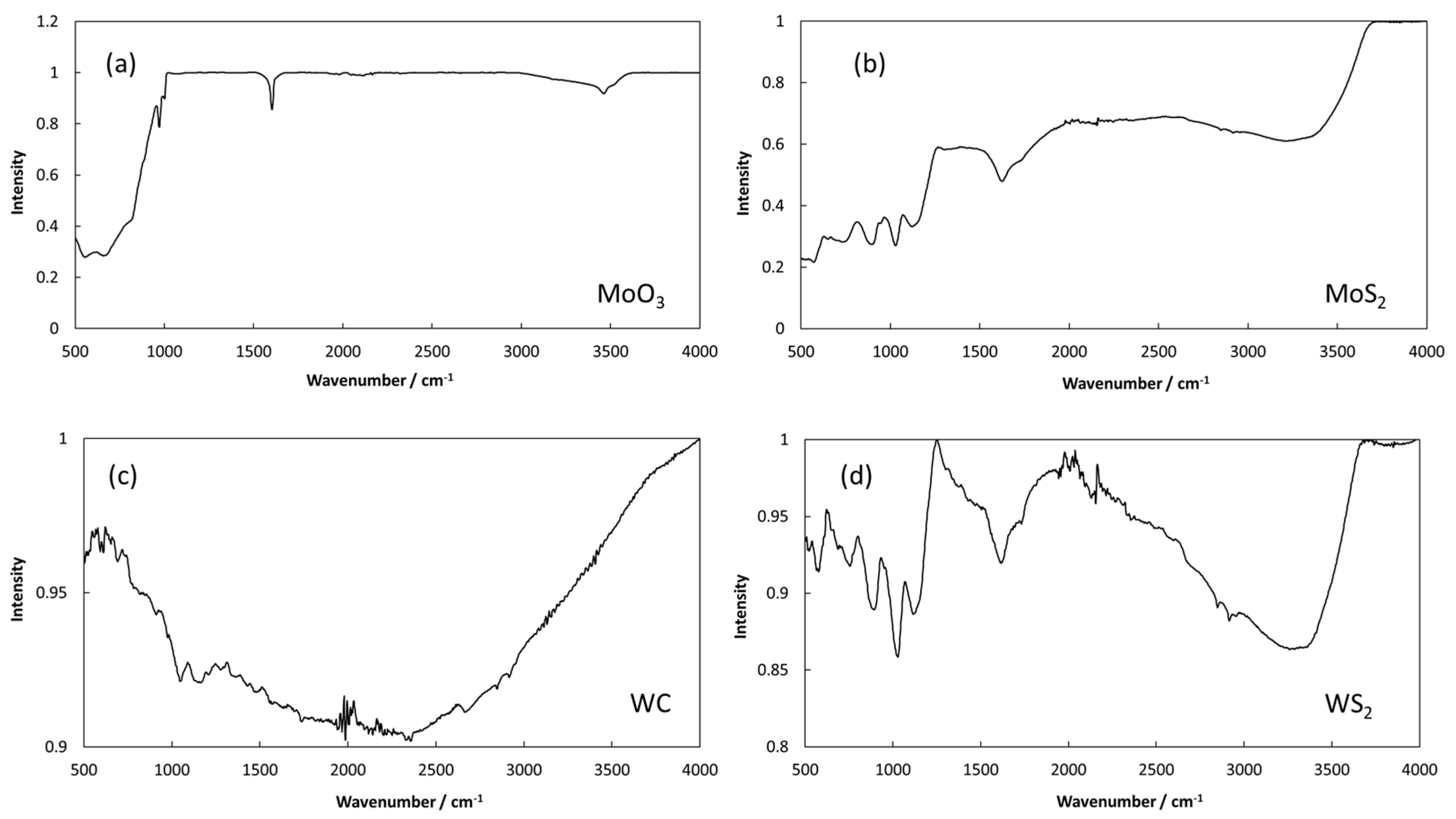


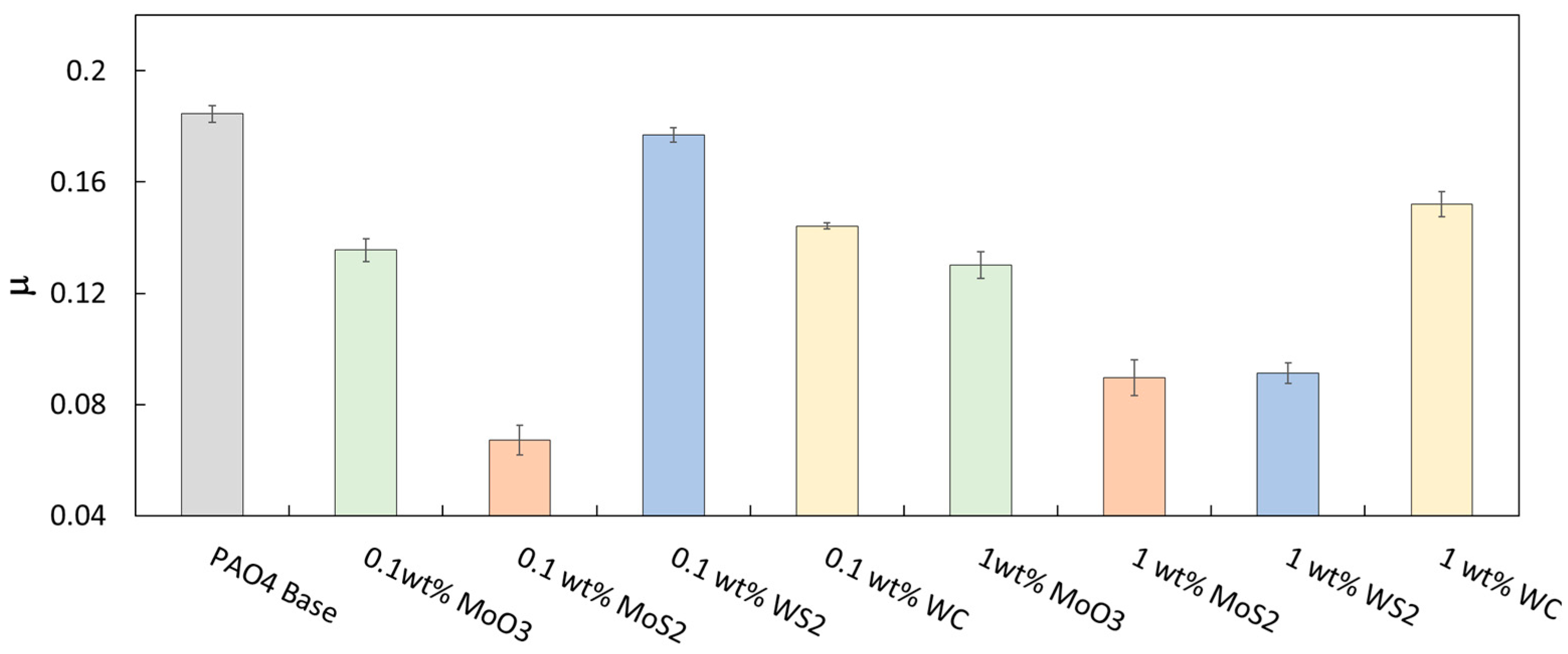
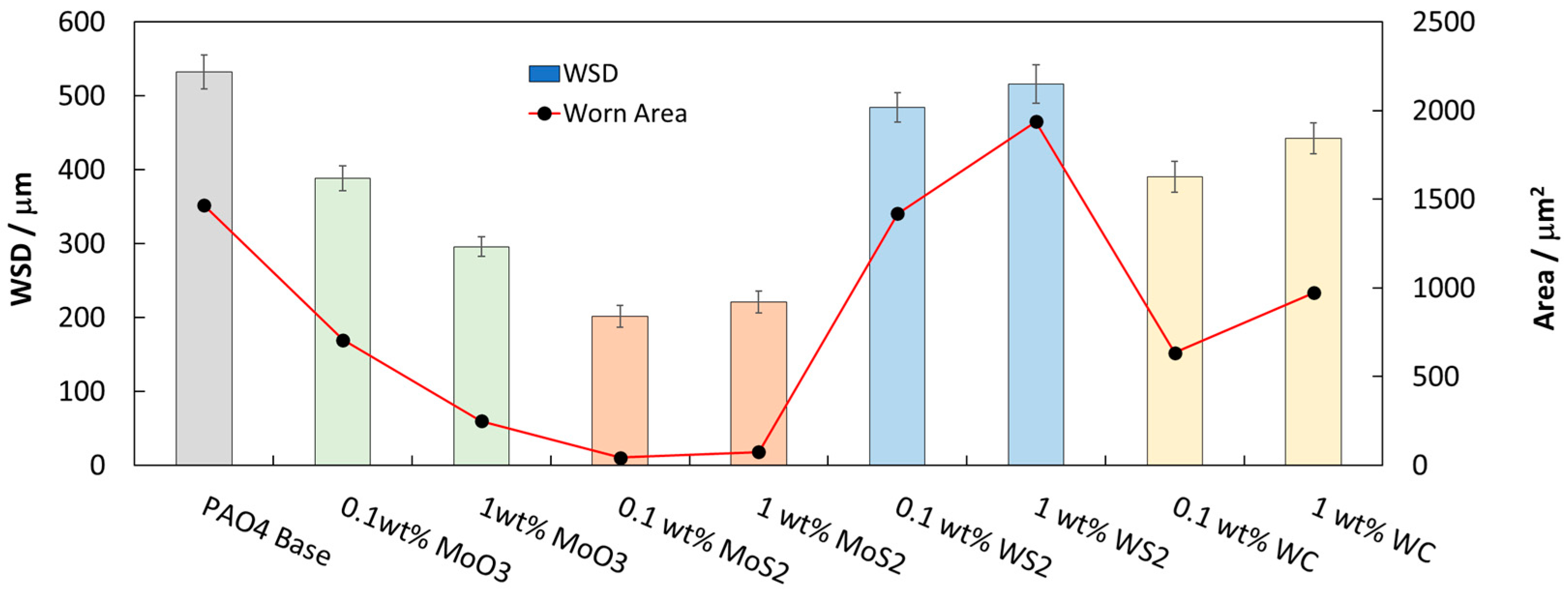
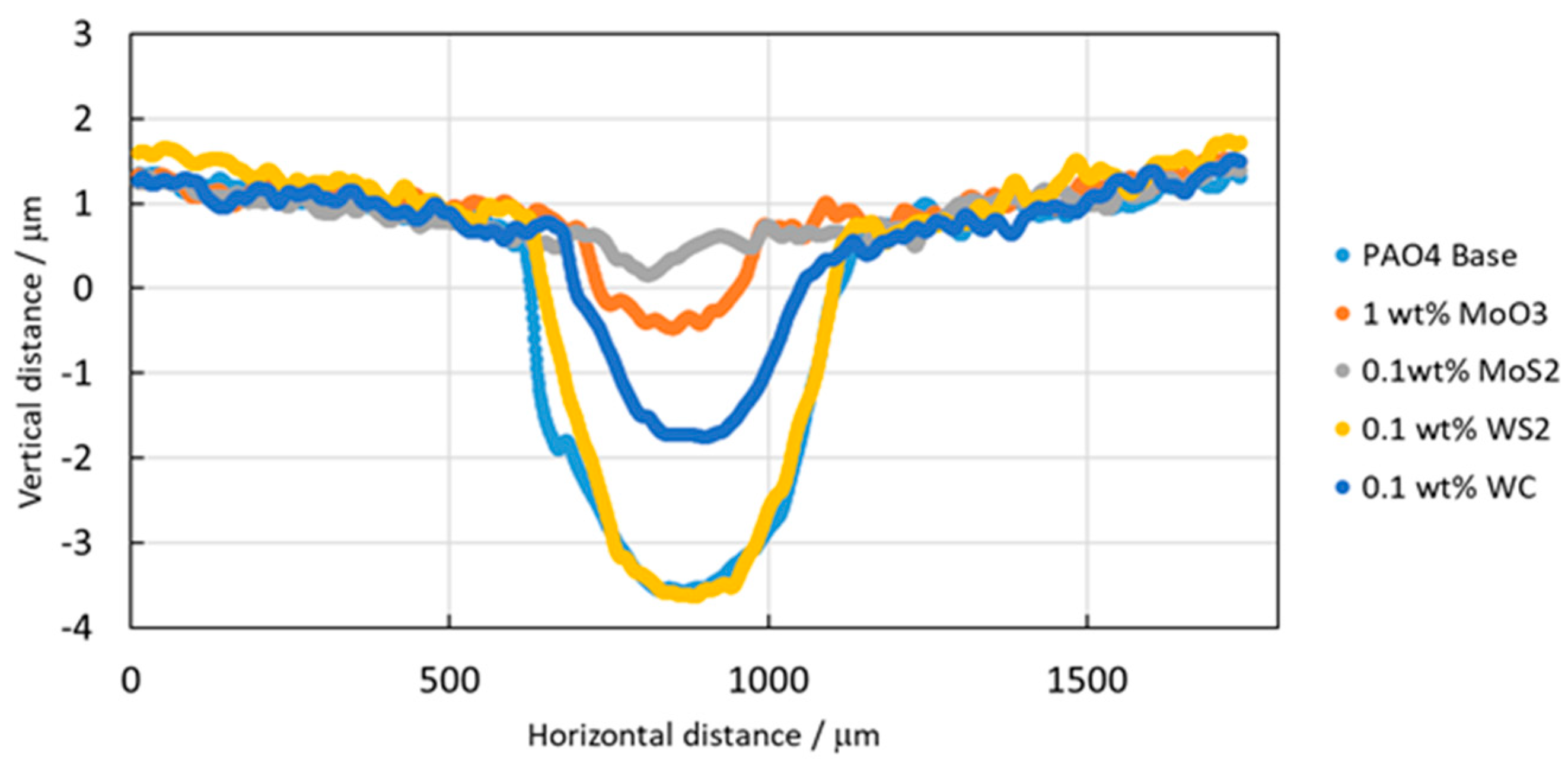

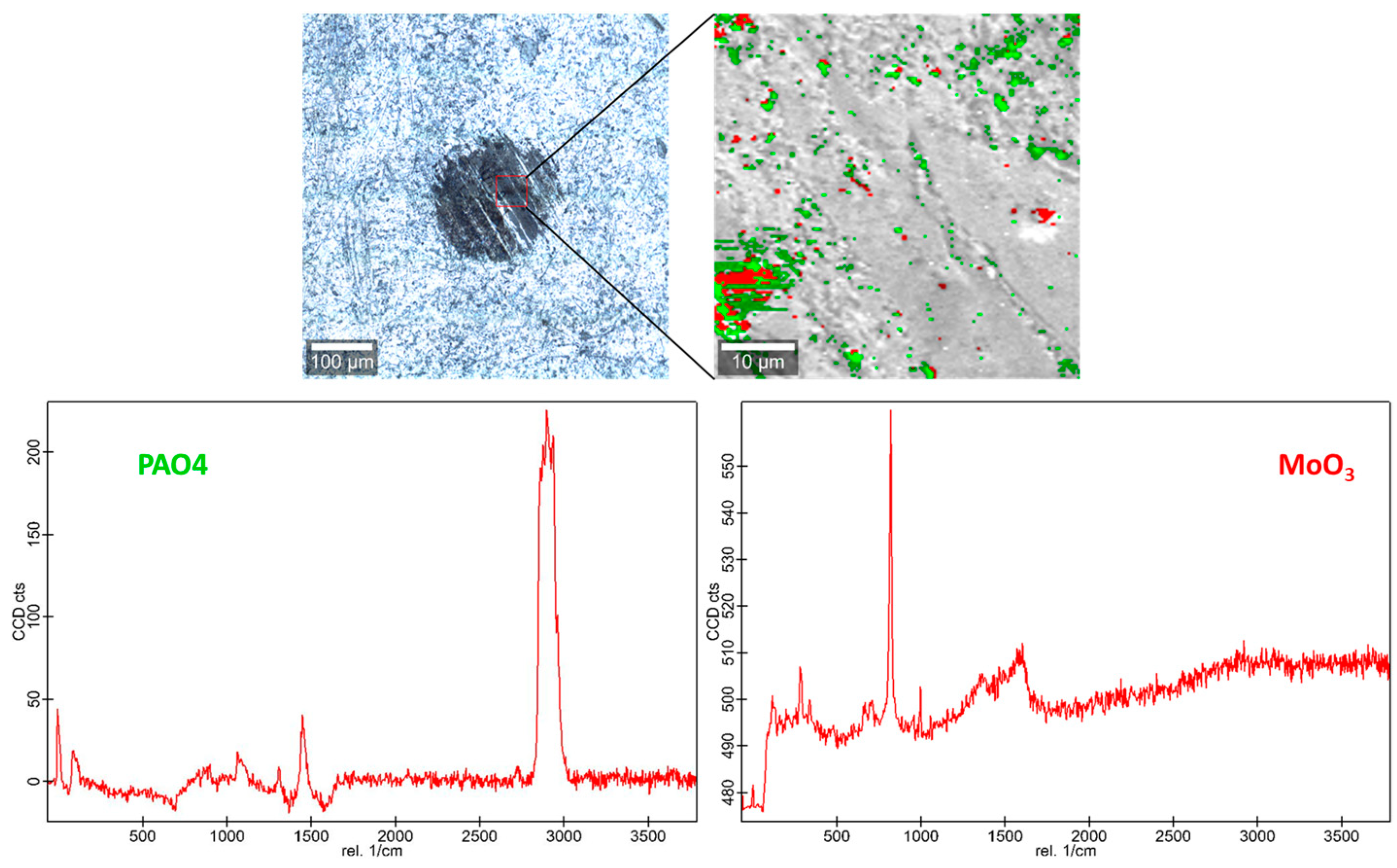

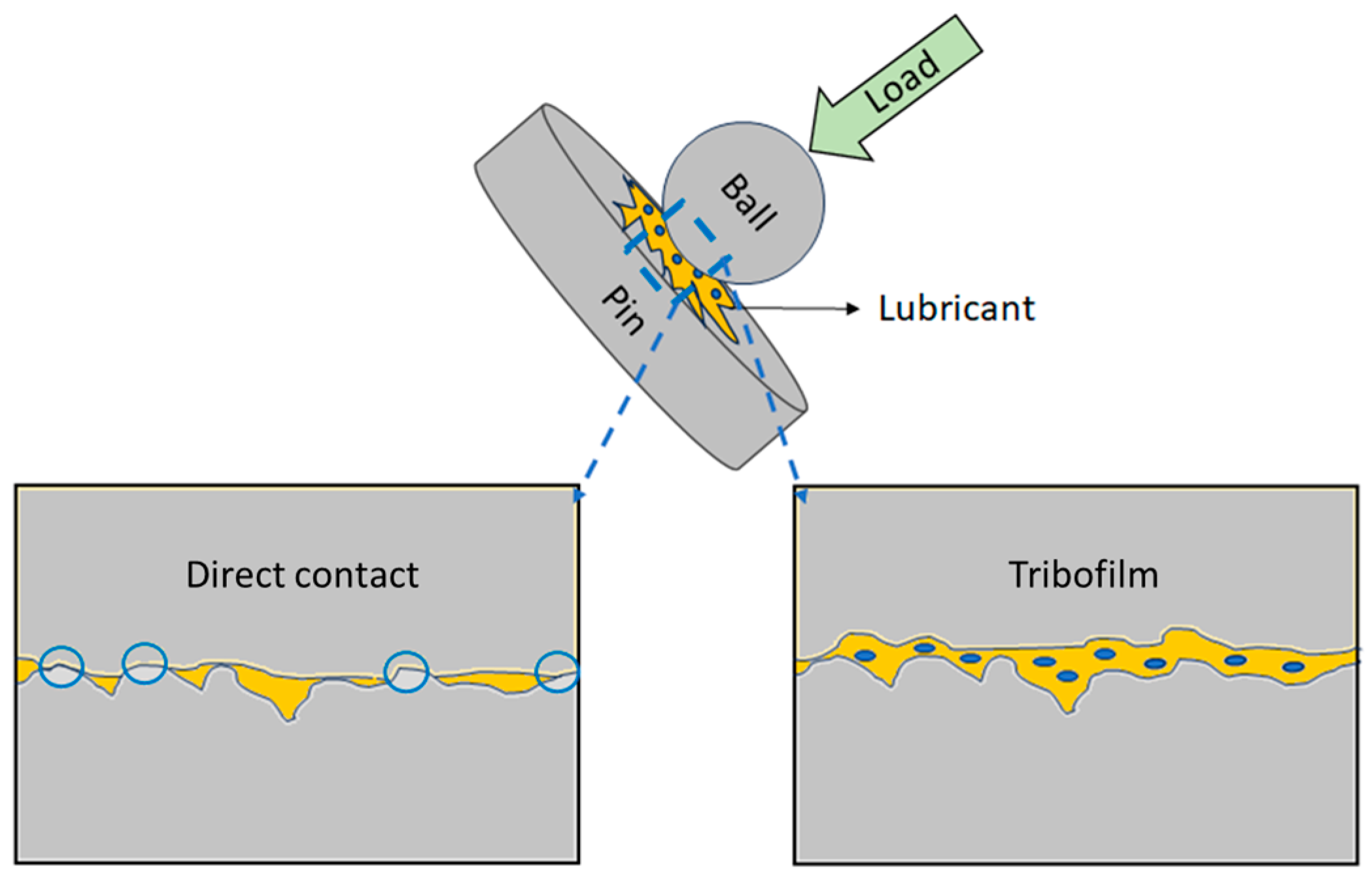
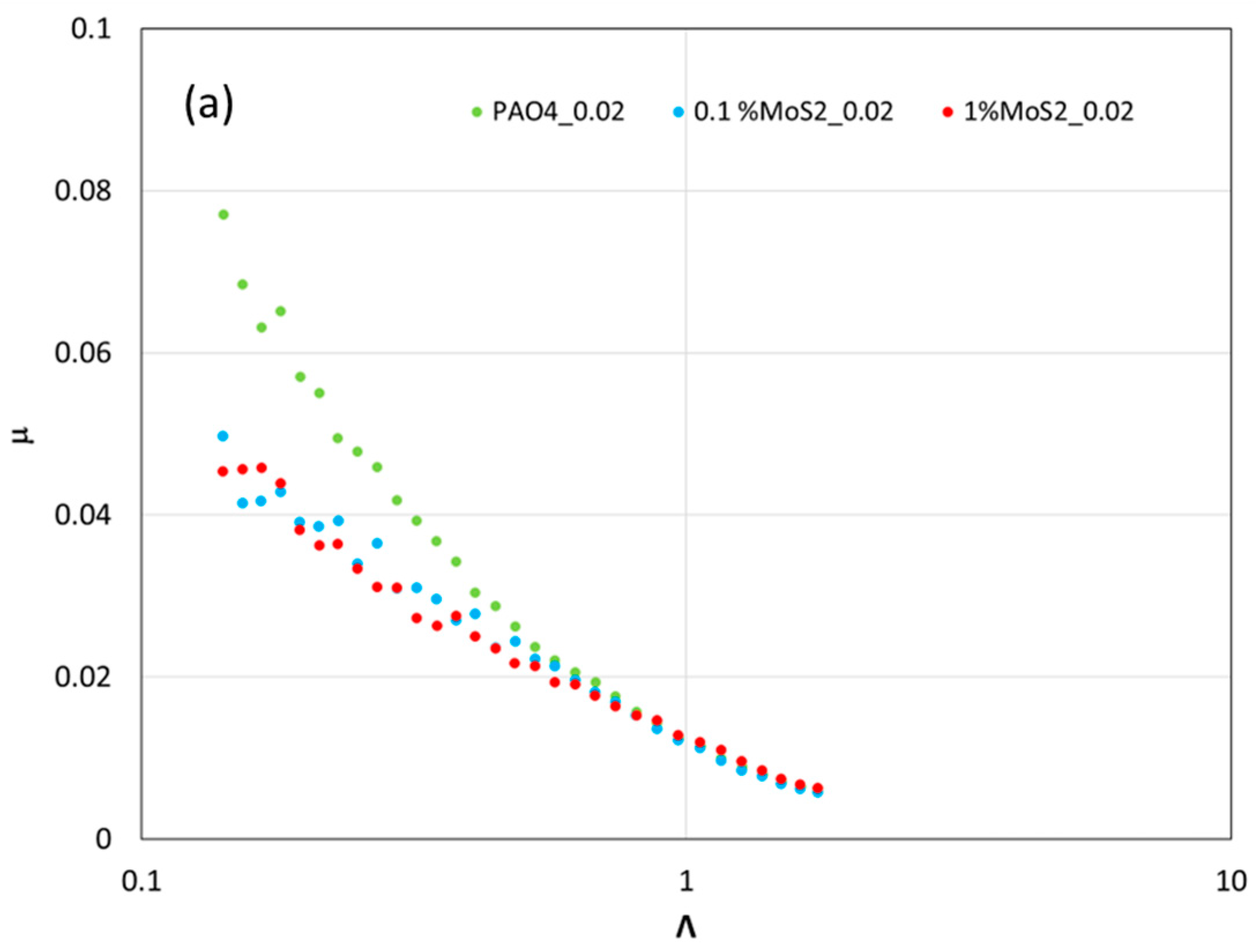

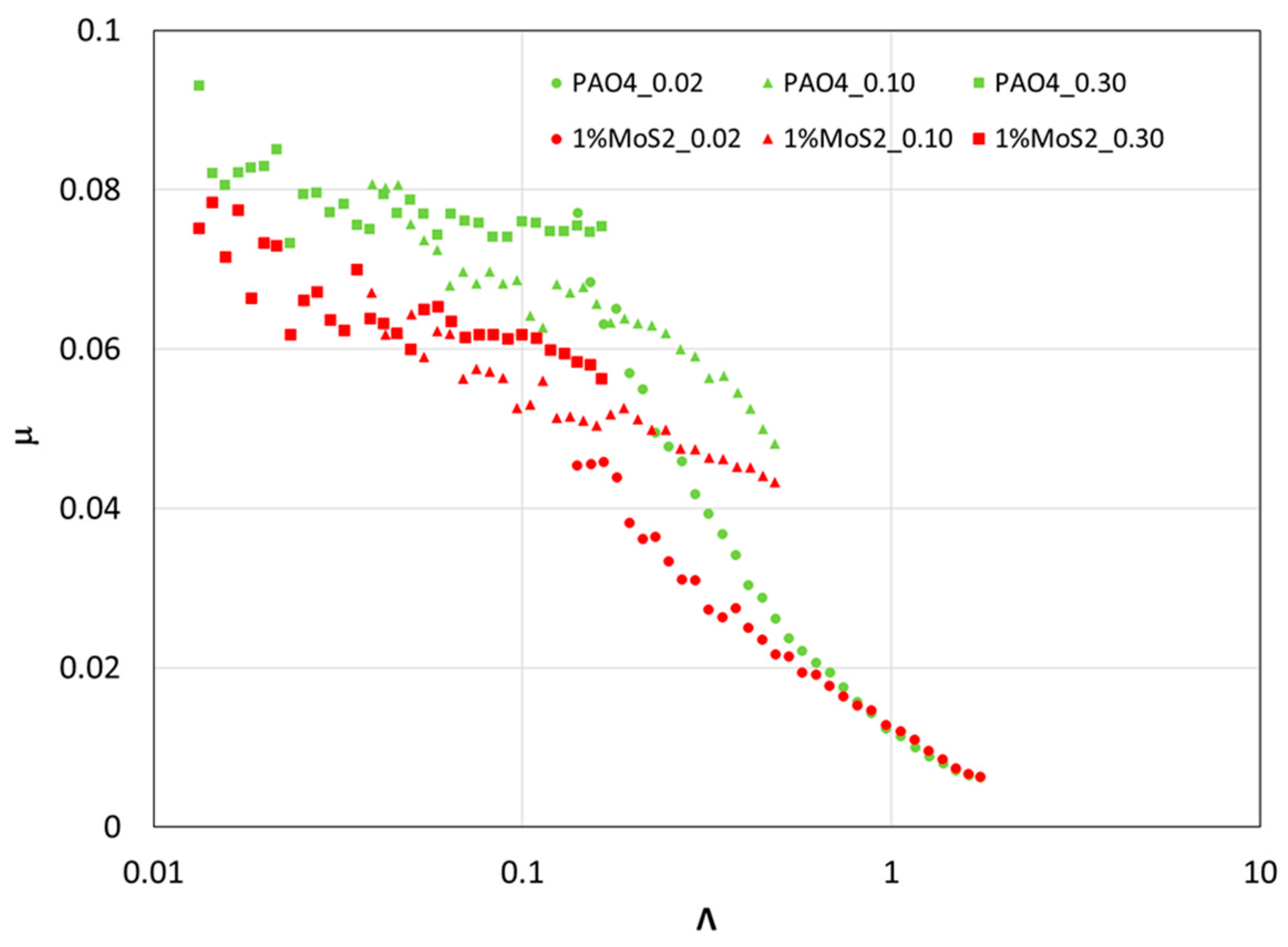
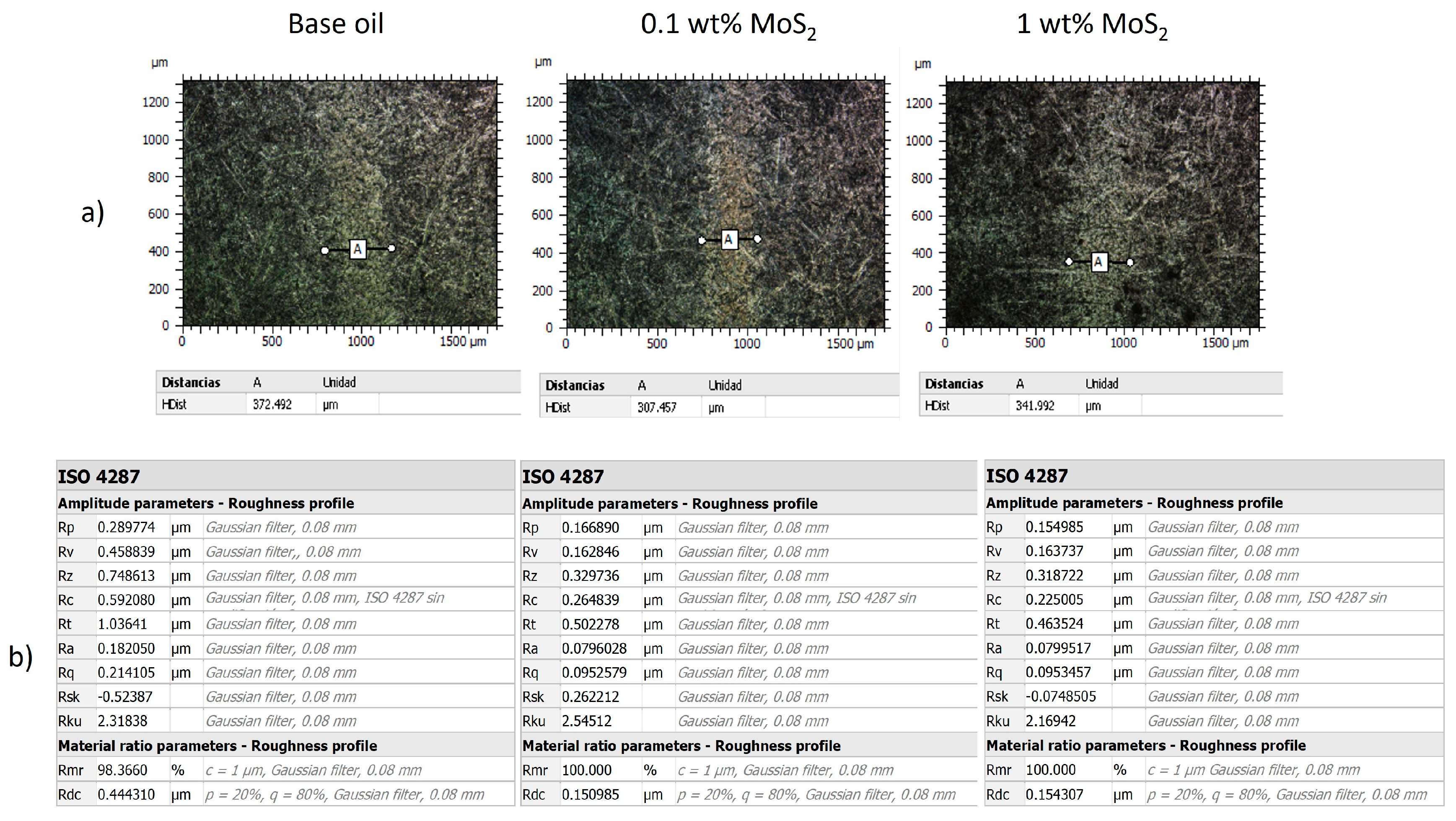
| Parameters | Steel Disc | Steel Balls | ||
|---|---|---|---|---|
| Smooth | Rough 1 | Rough 2 | ||
| Elastic modulus/GPa | 210 | 210 | 210 | 210 |
| Poisson coefficient/GPa | 0.29 | 0.29 | 0.29 | 0.29 |
| Diameter/mm | 100 | 19.05 | 19.05 | 19.05 |
| Surface roughness, Rq/nm | 20 | 20 | 100 | 300 |
| Lubricant | µ | σ | WSD/μm | σ/μm | WTD/μm | σ/μm | Area/μm2 | σ/μm2 |
|---|---|---|---|---|---|---|---|---|
| PAO4 | 0.1845 | 0.0029 | 532 | 23 | 4.70 | 0.49 | 1467 | 184 |
| +0.1 wt% MoO3 | 0.1355 | 0.0040 | 388 | 17 | 2.37 | 0.32 | 707.1 | 102 |
| +1 wt% MoO3 | 0.1302 | 0.0048 | 296 | 13 | 1.44 | 0.13 | 250.3 | 56.8 |
| +0.1 wt% MoS2 | 0.06713 | 0.00543 | 201 | 15 | 0.30 | 0.04 | 44.20 | 10.5 |
| +1 wt% MoS2 | 0.08971 | 0.00643 | 221 | 15 | 0.45 | 0.08 | 75.78 | 12.7 |
| +0.1 wt% WS2 | 0.1770 | 0.0027 | 484 | 20 | 4.35 | 0.51 | 1420 | 196 |
| +1 wt% WS2 | 0.09125 | 0.0037 | 516 | 26 | 5.37 | 0.65 | 1939 | 230 |
| +0.1 wt% WC | 0.1442 | 0.0010 | 390 | 21 | 2.52 | 0.33 | 634.3 | 106 |
| +1 wt% WC | 0.1521 | 0.0044 | 442 | 21 | 3.58 | 0.52 | 972.4 | 121 |
| Lubricant | Ra/nm | σ | Rq/nm | σ |
|---|---|---|---|---|
| PAO4 | 31.8 | 2.9 | 41.4 | 4.2 |
| +0.1 wt% MoO3 | 27.5 | 2.1 | 32.7 | 3.3 |
| +0.1 wt% MoS2 | 10.1 | 1.3 | 13.0 | 1.5 |
| +0.1 wt% WS2 | 23.6 | 2.3 | 28.2 | 2.5 |
| +0.1 wt% WC | 21.3 | 1.9 | 26.2 | 1.8 |
| +1 wt% MoO3 | 16.2 | 1.4 | 20.1 | 2.0 |
| +1 wt% MoS2 | 11.1 | 1.2 | 13.9 | 1.4 |
| +1 wt% WS2 | 29.3 | 2.6 | 34.9 | 3.7 |
| +1 wt% WC | 27.5 | 2.3 | 31.2 | 3.0 |
Disclaimer/Publisher’s Note: The statements, opinions and data contained in all publications are solely those of the individual author(s) and contributor(s) and not of MDPI and/or the editor(s). MDPI and/or the editor(s) disclaim responsibility for any injury to people or property resulting from any ideas, methods, instructions or products referred to in the content. |
© 2024 by the authors. Licensee MDPI, Basel, Switzerland. This article is an open access article distributed under the terms and conditions of the Creative Commons Attribution (CC BY) license (https://creativecommons.org/licenses/by/4.0/).
Share and Cite
Liñeira del Río, J.M.; Fernandes, C.M.C.G.; Seabra, J.H.O. Tribological Improvement of Low-Viscosity Nanolubricants: MoO3, MoS2, WS2 and WC Nanoparticles as Additives. Lubricants 2024, 12, 87. https://doi.org/10.3390/lubricants12030087
Liñeira del Río JM, Fernandes CMCG, Seabra JHO. Tribological Improvement of Low-Viscosity Nanolubricants: MoO3, MoS2, WS2 and WC Nanoparticles as Additives. Lubricants. 2024; 12(3):87. https://doi.org/10.3390/lubricants12030087
Chicago/Turabian StyleLiñeira del Río, José M., Carlos M. C. G. Fernandes, and Jorge H. O. Seabra. 2024. "Tribological Improvement of Low-Viscosity Nanolubricants: MoO3, MoS2, WS2 and WC Nanoparticles as Additives" Lubricants 12, no. 3: 87. https://doi.org/10.3390/lubricants12030087





